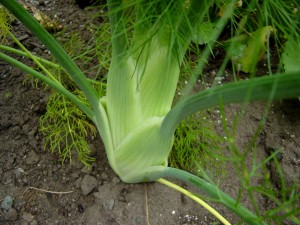 Fennel (Florence Fennel) – Fenkoli
Fennel (Florence Fennel) – Fenkoli
Foeniculum vulgare
Apiaceae family
There are two forms of fennel, the herb or leaf varieties grown for their leaves, stems and seeds, and Florence fennel (var. dulce) grown for its bulb like thickened petioles (leaf stalks). Both are known for their anise or liquorice flavour. Leaf fennel will grow to over 1m tall and has finer stems and leaves than the shorter Florence fennel, which has thickened stems and coarser dark green leaves. The whole plant is edible, but its best to choose the correct variety to suit your needs, for example avoid using the coarser leaves of Florence fennel for garnishing or in leafy salads.
Florence fennel takes 80-90 days to grow, the leafy varieties can be harvested earlier by cutting the foliage as it grows. if seeds are required then they can be collected after drying the mature flowers. Florence fennel is not easy to grow due to the sensitivity to bolting (prematurely producing flower stem), which greatly reduces the quality of the bulb. Bolting is caused by long day length in early summer and stress caused by for example poor plant quality, dry conditions or intense weed competition. By choosing the best varieties, paying attention to crop husbandry and planting as the day length shortens after midsummer the chance of success is greatly increased but not guaranteed.
After harvest the leafy fennel is treated similarly to dill, it must be kept cool and moist and used as soon as possible. For florence fennel the leaves and upper stems should be cut away from the bulb using a sharp knife, this will help to avoid rapid wilting and allow the bulb to be kept for up to 1 week in a fridge. As with many vegetables and herbs, the flavour and fragrance is closely linked to volatile essential oils and the longer the plant is kept after harvest the more fragrance dissipates. This is particularly evident in fennel, dill, parsley and many herbs, and is the reason why these plants should always be used as soon as possible after harvest if you wish to get the best results.
Typical quality problems with fennel are wilting and yellowing of older and poorly kept leaves, small narrow bulbs or bulbs elongated due to bolting. A good quality fennel bulb should feel heavy for its size, be broad in shape and have a clean white colour.
For our Welsh speaking visitors ´Mae ffenigl yn gwneud salad hyfryd, wedi´u sleisio´n denau gyda dresin vinaigrette clasurol`.

